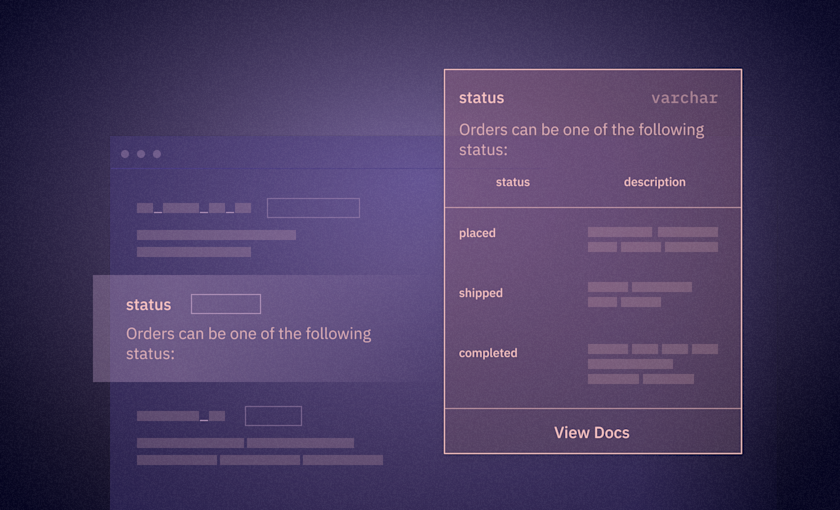Blog
Getting the most out of dbt docs
Bringing all the power of dbt’s documentation site, straight into Hex

TLDR: Hex now surfaces descriptions from a dbt Cloud project directly in the database schema browser in Hex. Read on to learn a bit about why we built this and our thoughts on writing valuable docs, or head straight to our docs to set up the integration.
You’re a good data analyst — a great one, even. You transform your data with dbt, and take the time to come up with clear and understandable names for your columns and tables. When you discovered the in-built dbt docs site, your mind was blown, and since then, you’ve spent hours documenting your sources and models, crafting beautiful descriptions for the columns and tables your team use in analyses.
You deploy the dbt docs site at a URL that everyone on your team can access, and even run data onboarding sessions to train people, showing them how to find the definition of a column without ever needing to ask for help. If anyone on your team wants to know what a column means, the information is right there, in the docs.
So why do you still get messages like this?!?

This isn’t some fable I’ve constructed for the sake of a blog post: this was actually happening internally at Hex. No matter how much effort our incredible data team put in to their data docs, people were still pinging them asking what various columns and tables meant.
And honestly — I don’t blame them! Asking users to visit a separate docs site to open a new tab, remember a login, and navigate a UI to get the answer to their question is too much friction, especially when they can cmd + tab to another app and send you a message in a fraction of the time.
So, rather than try to lead our team members to the docs, we decided to bring the docs straight to them.
All your dbt descriptions, where you’re actually working
With the latest set of improvements to our dbt integration, model, source, and column descriptions are now surfaced directly in the database schema browser in Hex.
Alongside the docs, Hex also shows what tests are on each column, and the status of those tests. And if your users do want to see more context, there’s a handy, in-line link that will take them directly to the dbt docs site.
We turned this feature on for our internal dbt docs a couple of months ago, and its impact was immediate. Gone were the messages about what a column meant, and in their place were compliments on how well our data was documented.

The missing piece all along was bringing docs into the UI people were actually using.
Finding value in data documentation
This story had a happy ending, but not all stories of data documentation efforts do. I’m a huge fan of dbt, and the inbuilt docs site. Back in 2018, when I first saw an early prototype of the documentation, I was using a poorly-maintained spreadsheet for my data definitions. The docs site blew my mind: being able to write descriptions in the same repo, and as part of the same process as my data transformations, and then have a documentation site automatically generated for me was a game-changer. I envisioned a future where everyone in the org would use the docs site to understand how to use the datasets I was creating.
Since then I’ve seen countless data teams go through the same thing, whether it’s with dbt docs, or another data documentation tool — they invest hours writing definitions in the hopes that they’ll empower downstream users to discover and understand datasets; after all, that’s what these tools are promising. But most docs solutions don’t live up to this promise, and a lot of the effort of data teams is wasted.
I’m not saying data documentation isn’t valuable — there is value in writing descriptions to explain that complicated column, in understanding the lineage of data, and even in seeing where data is consumed. It’s just that most of this value today isn’t realized by the data consumer, it’s realized by the team producing the datasets.
We never really got to the Utopia these tools promised. If we do truly want to empower the consumers of our data to understand and discover datasets, we have to bring this metadata to the tools that our data consumers are using. The dbt docs integration in Hex is one part of that, and I’m excited to share more on this front as we continue to build Hex.